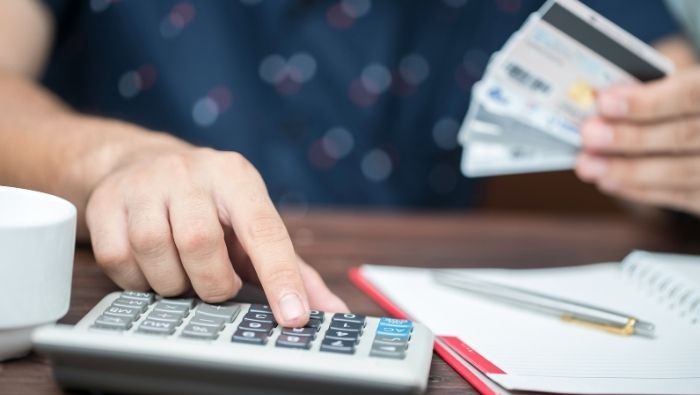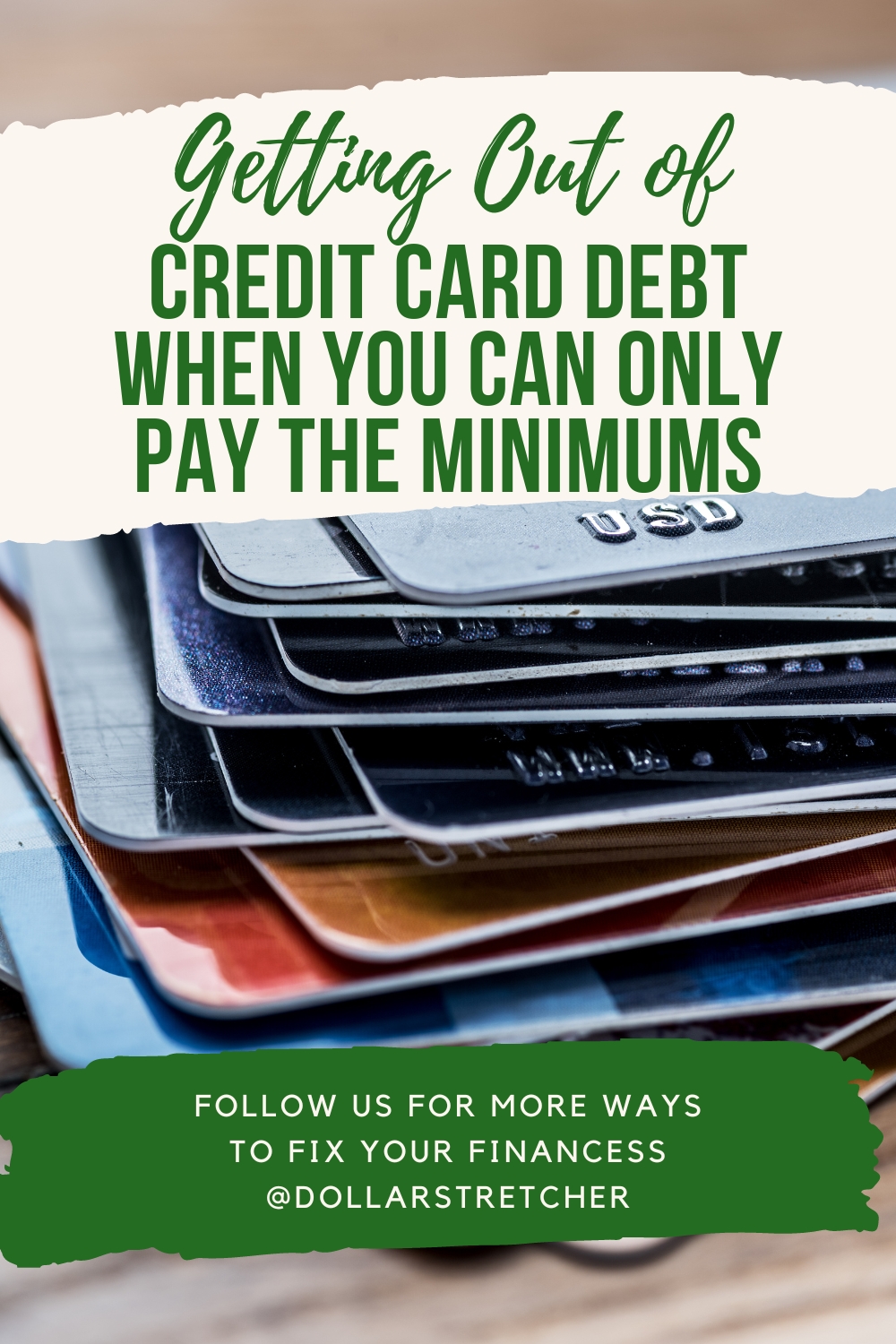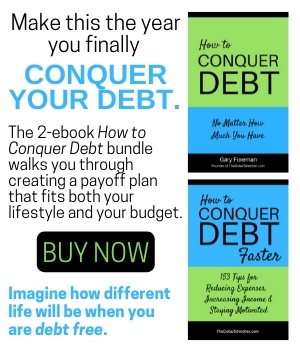Getting Out of Credit Card Debt When You Can Only Pay the Minimums
by Andrea Norris-McKnight

How do you lower your credit card balances when you can only make minimum payments? See if this strategy can help you make a dent in your debt.
Last month, my credit card statement balance was $2,048.75. The minimum payment due was only $29. According to my statement, if I only make minimum payments and do not make any additional charges with the card, it will take 11 years to pay off the balance and I’ll end up paying a total of $4,762. So those minimum payments would cost me about $2,700. And that’s assuming the card’s interest rate remains the same.
Only making minimum payments is expensive. Thankfully, my spouse and I put our monthly expenses on one credit card that we pay off in full each month.
But what if the minimum is all you can afford? How do you get out of credit card debt when you can only pay the minimums each month?
The following tips aren’t a miracle fix, but they can help you put a bigger dent in your monthly debt obligation.
Stop Charging
The first step is to stop using your credit cards. If you continue to use your credit cards, no plan will eliminate the debt. No credit counselor, debt consolidation loan or anything else will work.
(See Reduce Your Debt with a Sinking Fund if you keep using your card to cover those big occasional expenses, such as insurance premiums or property taxes.)
The only thing that’s going to help is to take a good, hard look at your spending habits and decide if you’re willing to make some lifestyle changes to solve the problem. (See What Are You Willing to Give Up To Win Financially?)
Sign Up for Savings
Subscribe to get money-saving content by email that can help you stretch your dollars further.
Twice each week, you'll receive articles and tips that can help you free up and keep more of your hard-earned money, even on the tightest of budgets.
We respect your privacy. Unsubscribe at any time.
Make a List of All of Your Credit Card Debt
Next, you need to get a feel of where you stand today. How much do you owe and how much are you adding in interest each month?
Make a four-column list. Gather all of your latest credit card statements. List the amount of the debt, the interest rate charged, how much interest is charged each month and what your minimum monthly payment is. Total all the columns except “interest rate.”
This list will give you a clearer picture of the debt mountain you’re facing and the amount you’ll need each month to contribute to your debt payoff plan.
Keep this list. You’ll want to refer to it as you make a plan to pay down your debt.
How To Get Out of Credit Card Debt When You Can Only Pay the Minimums
The goal is to maximize the amount of your monthly payments that go toward paying off the principal owed. Please note that I didn’t say that you need to pay more each month. Of course, if you do pay more, your debts will come down faster.
But can you accomplish the same thing without making a bigger monthly payment?
Commit To Your Current Minimum
Refer back to your list of credit card balances and make a note of the total minimum monthly payments. This is the amount you will pay each month until you are out of debt, even as your minimum payments decrease.
If you aren’t adding to your credit card balances, your minimum payments will decrease over time. But you want to keep paying that same minimum that is on the list you made. Let’s say your current total monthly minimum is $400. Barring some financial emergency, you will put $400 toward your credit card debt every month until all cards are paid off.
Get Help Paying Off Credit Card Debt
Use these guidelines to choose the best plan to pay off your credit card balances.
Start With the Card With the Highest Interest Rate
Take another look at your list. What’s the highest rate of interest on the list? That’s the debt that you’re going to attack first. It’s the one that’s inflating the “interest charged” total the most.
Where will you get the money? If you’ve been paying more than the minimum on any accounts, change your strategy to just pay the minimum on those and then apply the extra to your high-interest target account. If you haven’t been paying more than the minimums, keep plugging away until your minimums begin to come down. As your minimums decrease, pay those new minimums and put the difference toward your high-interest rate card until it is paid off.
As you pay down your debt, you’ll have additional money available to you. Add that extra to what you’ve already been paying on the highest-interest debt. As you begin to reduce the interest charged, you’ll find that you’re paying off your debt faster and faster.
That is why this method is known as The Avalanche and it is the only method that is going to make a dent in your debt when you can’t really pay much more than your minimums. First, you eliminate the account with the highest rate. Then, that money is applied to the next highest rate account. It gets easier as you go. And you always pay that same $400, or whatever your budgeted monthly minimum debt payment is at the start of your debt repayment.
A Few Tricks That Can Make Your Pay Down Efforts More Efficient
The first is to call the credit card companies and ask for a lower rate. Stress that you’ve paid on time. Or that you’ve been a long-time customer. Even if you can’t think of any reason, try anyway. You have nothing to lose but the phone call. It’s surprising how often a rate will be lowered if you ask.
The second thing you can do is to transfer the debts to a lower-cost card. Perhaps it’s to a card that you already carry. If so, make sure you know if you will be charged a fee for the balance transfer. Depending on the fee, you might not wish to make a transfer to an existing card, even if the balance transfer comes with a low rate. Do the math to make sure a transfer will actually help you pay down your debt faster.
Or you might need to compare balance transfer cards and apply for a new one. A new card will often allow fee-free balance transfers. Look for one that has a low introductory rate. Some will even have a 0% introductory rate. Even if it’s only for six months or a year, you’ve lowered your interest charges and found some money to pay off the principal.
Finally, whenever you have a bit of extra cash in your budget, even if it’s only $10 or $20, put it toward your highest-interest credit card. You will be surprised what a difference this can make.
The Key To Paying Off Your Debt
Just one more reminder — you will keep paying the same amount towards all the accounts combined as you did before.
If you’ve been putting $400 toward your debt each month, make sure that all your payments still total $400, even when your minimums drop to $300. But, any money over the minimum amount due on each account will go to the highest-interest account.
Does the Strategy Work?
Try it for three months and then make a new list. Then, compare the two lists. You should see that both the total amount of interest charged and the total amount of debt are coming down.
That’s important. You need encouragement to reach your goal. Compare your lists and see what you’ve accomplished.
It’s a good feeling when an account ‘bites the dust.’ In fact, some advisers suggest that you take a smaller account and pay it off first. In any case, when you get discouraged, compare your current list to the one at the beginning. Then pat yourself on the back!
Takeaway
Paying off credit card debt can feel like “throwing money away.” The money you spend on interest charges doesn’t buy you any more food, housing or goodies.
Ask yourself a question. Suppose you had the money you spend on interest payments each month because you were debt-free. If you used that money for you and your family, how much better would your life be?
Keep that thought in mind as you pay down your debt and someday you will get there.
Reviewed December 2023
About the Author
Andrea Norris-McKnight took over as the editor of The Dollar Stretcher and After 50 Finances after working under the site founder and previous editor for almost 15 years. She has also written for Money.com, GOBankingRates.com, HavenLife.com and The Sacramento Bee.
Sign Up for Savings
Subscribe to get money-saving content by email that can help you stretch your dollars further.
Twice each week, you'll receive articles and tips that can help you free up and keep more of your hard-earned money, even on the tightest of budgets.
We respect your privacy. Unsubscribe at any time.
Popular Articles
- 7 Habits of Highly Frugal People
- 5 Simple Budget Cuts That Can Save $200 a Month
- How to Track Down Unclaimed Funds Owed You
- 32 Ways to Save Money on Your Utility Bills
- Do You Need Credit Life Insurance When Buying a New Car?
- How to Maximize Profits When Selling Online
- Staying Motivated to Continue Digging Yourself Out of Debt

On After50Finances.com
- 9 Things You Need to Do Before You Retire
- You Didn’t Save Enough for Retirement and You’re 55+
- When Empty Nesters Reorganize and Declutter Their Home
- Reinventing Your Career in Your 50s or 60s
- What Mature Homeowners Should Know about Reverse Mortgages
- 2 Reasons to Collect Social Security Benefits As Soon As Possible

